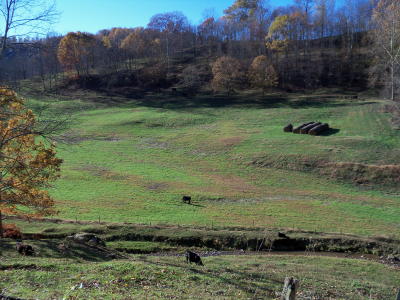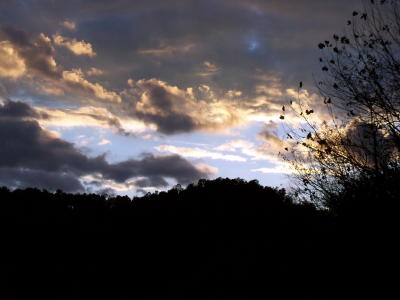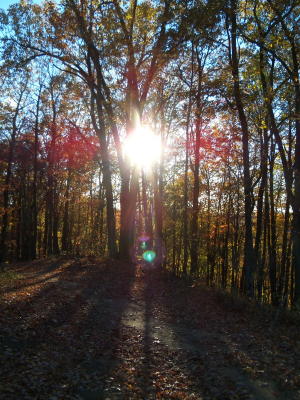THE GHOSTS OF THE THREE LAUGHLINS - After Tragic Deaths, Do They Still Wander The Calhoun Hills?

The environs of the Spring Road and Rush Run areas have remained
much like the time recalled in James Haught's story about the fate
of some of the Laughlin family, Haught's roots are in the the hollow
By James C. Haught
Hagerstown, Maryland
Just south of Arnoldsburg there are three creeks coming into the West Fork. They are Spring Run, Anthony Run and McCunes Run. Just west of McCunes Run is Camp Hill where the Skirmish of Arnoldsburg took place.
If one walks up either one of these creeks they will come to Road Run. From Road Run one can go up Beech a short distance and turn left on Cooks Fork. Crossing over the low gap at the head of Cooks Fork one goes down Rush Run to Orma. Paralleling Spring Run to the east is another small hollow that we called Sumpter. This story takes place in this area.
Back in the early '40's Bob Moneypenny and I had gone up to the head of Anthony Run. There is a Tea Table rock located there. When we came near it we could hear someone singing "I'll Fly Away." We ran down and told our grandmother, Lydia Hoskins, what we had heard. She said that it was probably the Ghost of Alva Laughlin.
She said that Alva Laughlin was killed at the Skirmish at Arnoldsburg in May, 1863. The Laughlin family supported the Union, so Alva was a Yankee. Most of the people around here were Confederates, including George Downs, head of the Moccasin Rangers.
There was no fresh water on Camp Hill. Since Alva knew were the springs were on Spring Run, he brought two buckets down to get some fresh water. He was captured by a squad of Confederate soldiers.
They all knew Alva and he knew them.
Their corporal suggested they shoot Alva. They tied him up good and tight and stood him in the corner of a chestnut rail fence. One private pointed a gun at his leg and pulled the trigger. Alva fell in agonizing pain when the miniball went through his ankle. The other members of the squad tormented him by stabbing him with their bayonets. Finally, someone said, "He knows all of us. We had better kill him."
All five put a miniball through his body.
As one last indignity they took off his bullet-ridden vest and sent it to his wife, Dianna, who lived on Road Run. My grandmother said that Alva loved to sing and that some people believed his ghost still wandered the hills singing mainly hymns.
She said that the ghost would usually go up McCunes Run, cross over the low gap and go down Sauls Fork and Road Run. It would then go up Beech and Cooks Fork and stop for prayer at Fairview Church.

Could the ghosts of the Laughlin men still be roaming the Calhoun hills?
Alva's ghost would then walk around the ridge and come off of the hill at the Marks-Moneypenny house. Alva would stop there and get a drink of water. He then completed the circuit by crossing the low gap between Spring Run and Anthonys Run.
That was the story of Alva Laughlin as told by my grandmother, Lydia Hoskins.
Alva Laughlin had a nephew, Lemuel, who hung himself in his jail cell in Ripley, WV. That was in June, 1920. Lemuel Laughlin was convicted of moon-shining and bootlegging. He had stills on Sumpter and Rush Run.
When Lemuel was arrested he was a strong, handsome, robust man. Because the authorities were afraid he would escape they put him in small cage type cell. It was an iron cube, 8 x 8 x 8 feet. The cell contained only a bed and a slop jar. Lem quickly changed to an emaciated, withdrawn person.
One night he tied his bed sheet to the overhead bars and tightly around his neck. It was only a two foot drop from the bed to the floor. Lemuel Laughlin choked to death, a long, agonizing death.
The next day the authorities contacted Lemuel's widow, Amanda, who lived on Rush Run near Orma. They told her they would ship his body to Spencer but someone would have to pick it up. Some neighbors with a team of horses and a wagon picked up and delivered the body to Amanda. Lemuel Laughlin was buried in the Greathouse Cemetery on Rush Run.
People who live in the area say that occasionally on summer nights they will find the soil over Lemuel's grave disturbed.
I can remember while fox hunting with Smith Cottrill and my uncle, Buster Hoskins, we would hear this voice from some of the higher points. It would say, "Come on over and have a drink of good moonshine whiskey."
Buster and I were interested in going, but Smith would say, "Boys, it is just a waste of your time. That is just Lem Laughlin. If you go over there, then you will hear the same thing coming from this point." They say that Lemuel Laughlin is up there yet.
The day was Wednesday, August 12, 1936. Hattie Starcher, her step-daughter, Gracie Starcher and Dora Butler were stringing beans when they heard a shot from a high powered rifle.
In just a few moments, they saw Dee Laughlin, (Dora and Lemuel's brother) come running around the hill. Dee ran a short distance and sat down. There was another shot. Dee appeared to be resting his body on his knees, sitting there for a long time.
Homer Norman went over to check on him and discovered Dee had been shot. The bullet had entered his back in the area of the right scapula. It had come out of his chest just below his arm pit. A piece of Dee's rib lay on the ground in front of him.
Homer got some men and they carried Dee's body over to the house and laid him on the porch. One of the men drove into Orma and called the Sheriff of Calhoun County. There was a long investigation by Sheriff P.P. Gunn, State policemen D.G. Wilfong and O.C. Bowles and Justice of Peace Donald Altizer. No one was ever indicted for the murder of Dee Laughlin.
1936: LACK OF CLUES IN BIZARRE MURDER OF CALHOUN MAN
At the same time of Dee's death, my grandfather Jim Hoskins and Clay Moneypenny were cutting oats in a field just up from the low gap that goes over into Anthonys Run.
My grandmother had just brought them their lunch. She had covered a gallon jug of water with several layers of burlap and wetted it. The evaporation of the water would keep the water cool. It was a hot summer day. She took Bob Moneypenny and me along with her and we played on an old quilt near where the men were working.
All at once there came a large block of air through the low gap. Although it was air one could clearly make out a difference. The block was about the size of an automobile. It came toward us blowing down a few shocks of oats.
As it passed over us, Bob and I covered up in the quilt. The air was very cold. It was cold enough to freeze the burlap cover on the water jug.
We watched as it swirled over Roy Tanner's house. It continued up Spring Run until it got to the Moneypenny house. From there it went up the small hollow between Pete Lane's home and the Moneypenny home.
Elaine Moneypenny was hanging clothes on the line. She said the clothes froze stiff just like on a January day. One could follow the block of air until it crossed over into Sumpter.
My grandfather checked his watch when the object crossed overhead. He found out later that it was exactly six minutes after the time that Dee Laughlin was shot.
Years later, my uncle "Buster" Hoskins took me over on Rush Run. We stopped by the house where they had laid the body of Dee Laughlin on the porch. He had bled on the boards of the porch. The woman who lived there said that she had used everything trying to remove the blood stains. She had used lye soap and hot water, Old Dutch Cleanser and Chlorox bleach, but nothing would remove the blood stains.

Strange happenings are still a mystery,
after tragedy befalls the Lauglins
Some old timers of that era thought that the ghost of Alva, Lemuel and Dee Laughlin still roam the hills just south of Arnoldsburg. As far as is known the ghosts have never harmed anyone.
All of these things happened before I was born or when I was a small boy. There were a great many superstitious people, especially my grandmother, Lydia Hoskins.
I am now an old man and all of the people that knew about these strange happenings are now dead. I regret that I did not get verification to back up my story before they died, for this would be a more believable story.
The Laughlins, Hoskins, Moneypennys, and Starchers are relatives or people who were dear to my childhood. I will probably never know what caused the strange happenings.
I am now a man of science. I do not believe there are such things as ghosts, but many times I have wondered who was doing the singing?
Who called out in the middle of the night for fox hunters to come and drink some whiskey?
What caused the quick change in the weather on a hot summer day?
Why blood stains can not be removed from boards on a porch?
It is all a strange mystery and perhaps it is an explanation for the shadows that now appear in a mirror in a house on Spring Run.
ARNOLDSBURG FAMILY CAPTURES GHOSTLY IMAGES